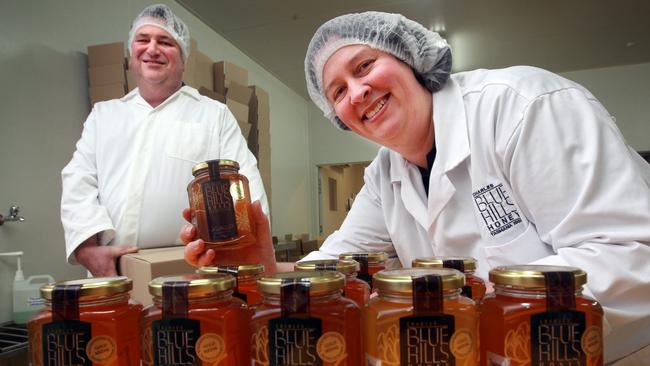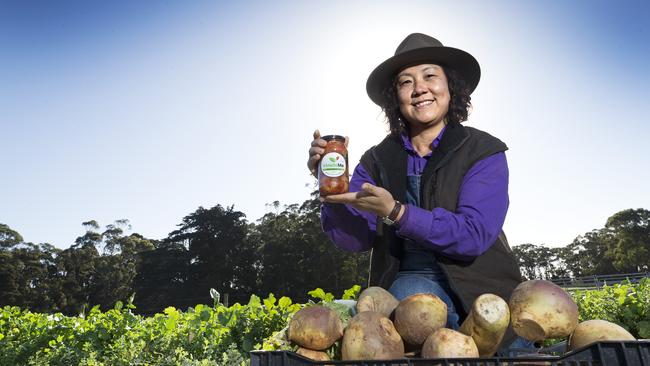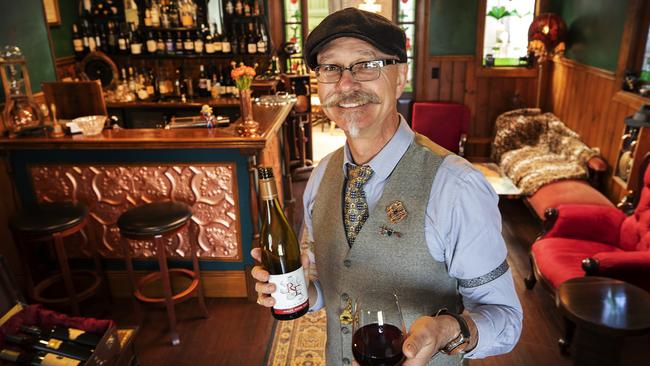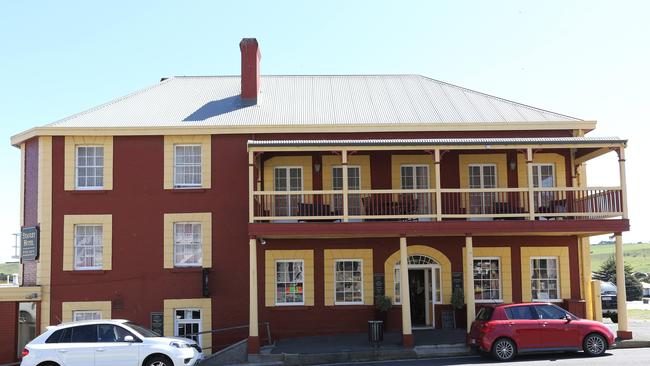Stanley Tarkine Forage Festival to rouse slumbering tourism giant
For too long, North-West Tasmania has been the sick man of our state. No longer. As Alex Treacy discovers, artisans and producers are making the region roar in advance of a new festival.

Tasmania
Don't miss out on the headlines from Tasmania. Followed categories will be added to My News.
“When I was growing up, the two daggiest places in Australia were Casino and Burnie.”
So says lawyer-cum-cockie Tom Glynn, of Wiltshire, who you will meet shortly.
This perception of Tasmania’s North-West as the stinky armpit of the state was, once upon a time, justified.
But, as I discover, it’s a reputation outgrown. For the North-West is, these days, brimming with producers and artists at the peak of their powers
Tasmania has worked hard over the past few decades in burnishing its reputation as a hub of cultural and gastronomic finery, but until now, the benefits have largely evaded the state’s North-West.
No longer. It’s a point set to be emphasised by the newest player in Tasmania’s burgeoning food festival scene, the Stanley & Tarkine Forage Festival.
Set over nine days in November, in the shadow of Stanley’s iconic Nut and the windswept surrounding hills, the festival puts a dramatic exclamation point on the region’s cultural revolution. I was lucky enough to have a sneak preview. These are the things I saw, the characters I met, the flavours I experienced.
HOME BASE
I’m staying at The Inlet, a five-minute drive from Stanley. Four contemporary beach houses stand just metres from the West Inlet. Fishermen cast lazy arcs on the hunt for flathead. We’re greeted with a welcome basket bursting with goodies: a nice red, a loaf of freshly baked bread from Stanley’s Providore 24, cheese and crackers, eggs and milk.
The sunlight bursts through the panoramic windows as I collapse into the sprawling bed – but only for five minutes. There’s lots to see.
QUEEN BEE
Mawbanna’s Blue Hills Honey (Mawbanna is where the captured the last thylacine, I am later told) has been in the Charles family since 1955.
Nicola and husband Robbie took it over about 20 years ago and have ridden the waves. In 2004, the wholesale market fell out “overnight”, plummeting from $4.80/kilo to $1.65. Tasmania’s honey, back then, was not viewed as a premium product. It is now, thanks in part to the Charles’.

We are taken on a tour of the facility, which recently had installed a virtual reality room for punters to stand a moment in beekeepers’ shoes. They say you don’t want to see how the sausage is made, but you definitely do want to see how the honey is made. It’s another world.
We finish with lunch in the light-filled The Colony cafe. We shared a baked brie lathered in honey and crowned with walnuts, and a three-cheese pizza featuring honey and ricotta.
The brie oozes like lava. It is divine.
KOREA BY THE SEA
Just 15 minutes up the road, at Wiltshire, you will find something you don’t expect: Seoul-born Sue Glynn selling jars of kimchi and cooking hot dishes which explode with savoury spice. Think bibimbap, Korean pancakes and kimchi jjigae (stew).
Ms Glynn owns a 100-acre hobby farm with her Red Angus cattle-rearing husband Tom, a lawyer. Three acres are devoted to her organic garden, which grows cabbage, daikon, beetroot, winter spring onions, tomatoes and chilli. They are harvested for her business Kimchi Me.

She is a disciple of Youngsang Cho, a Korean organic farmer who preaches responsible land management – “Look after the land and it will look after you,” she said.
Ms Glynn busily whirrs through her tiny kitchen while we natter with Tom and Cape Grim cockie Lex, who has visited to help install a pump.
Ms Glynn’s jjigae and Korean pancakes burst with authenticity. The secret to a Korean pancake is to balance the umami flavour, she says, hence why it is leavened with sultanas and cinnamon. They are topped with a divine sauce of cashew, lemon, and kimchi.
STEAMPUNK WINE ACADEMY
In one of Stanley’s original houses on the terrace, Mike Pine holds court – for it is his kingdom and he is king, jester and diviner all in one.
Wine bars can be stuffy, staid places full of silvertails, but Mr Pine ensures Stanley Wine Bar is the soul of merriment.
Mr Pine, an academic in his previous life, and partner Shelley Jackson are avid collectors – books, steampunk hats, taxidermied creatures.

Aside from being an eccentric, Mr Pine is also a genius. One only has to suggest a hint of desired flavours or varieties and he revs into action, probing his shelves and fridges for just the thing. Despite only having the faintest hint of guidance, he inevitably produces the drop to hit the spot.
“The overriding philosophy of what we do here is that it’s just nice. We’re nice to people. We like to have fun. We get nice people. We have amazing conversations,” Mr Pine says shortly after quizzing me on whether I knew what a memento mori was. A very typical question from Tasmania’s kooky wine king.
KING CRAY
If Stanley’s reputation as a hub for the finer things in life is well on its way to being assured, Hursey Seafood – “From our fleet to your plate,” is the well-deserved tagline.
The restaurant is humming with customers when we are seated and the diligent waitress arms us with a bottle of fine pinot noir in no time at all.
I have been looking forward to this for some time. Being from Queensland, my taste runs more towards Moreton Bay bugs than it does crayfish. Previously, I have found them lacking the oceanic firmness and zest I crave in my seafood.
Hursey’s crayfish set me on the right path. It was the pinnacle of my seafood-eating life thus far. The presentation was beautiful and the cold, sweet meat slid from the carapace like the running tide.
THE COLLECTOR
Where does Stanley’s Cow ‘N’ Calf Gallery owner David Murphy get all his artworks from? Well, people just bring them in to see if he likes them.
It’s the sort of laid-back, semi-accidental approach which got the former food processor to where he is – McCain gave him a redundancy, so he printed off 20 of his photographs and put them on a wall in a Smithton coffee shop.
“I sold the lot in three weeks,” he said.
Now, Mr Murphy is the purveyor of the beautiful, the unique and the out-of-the-box. Not for him wall after wall of generic Australian impressionism.
There’s a print from landscape photographer Rob Blakers which Mr Murphy reckons he has sold $60–$70,000 worth. There’s quirky bronze worker Jon Eismann, who mysteriously crafts himself holding a briefcase time and again. Forger Mick O’Brien, the “master blaster” is there too, as is furniture craftsman Toby Muir Wilson.
A SUICIDE UP HIGH
As previously mentioned, I am a banana bender. We haven’t done so well at preserving our history, so I was enchanted to walk through the grounds of Highfield Historic Site, the headquarters of the ill-fated Van Diemen’s Land Company.
The architecture. The gardens. The view of the yawning Nut, hazy blue in the distance. The history dripping from the walls. The smell of damp in the cellar.
I knew little of the history of VDL Co and I was fascinated by the titbits I picked up – such as that it was they who put the bounty on the thylacine, which led to its extinction.

Each room held hidden delights. Blink and you would miss one of the most moving exhibits, a small, laminated copy of the suicide note of Henry Hellyer, a key figure in VDL Co.
It was left on a small dresser, almost as an afterthought.
I took a picture of it, so moved was I. His final line before he shot himself was, “In an agony I fly to my saviour”.
THE MAD SCIENTIST
Matt Packwood-Hollings, of Table Cape’s Alchymia Distillery, may appear rough on the outside, but inside exists the soul of a scientist.
A tour of his distillery reveals a master who has armed himself with the tools to explore his burgeoning powers by hand – no machination for this Michelangelo.
The Latrobe-grown barley is hand sifted, to pick out nasties like snail shells and strands of cotton which make it into other drops. English ale yeast is added for flavour, distillers yeast for a “good, clean alcohol”.
The ferment goes for an extraordinary seven days – “it’s not yield or speed, it’s flavour,” he said.
It goes into Joyce – that’s his main still. Jerry-rigged onto Joyce is Muriel, the “vodka tower” jerry rigged onto Joyce. Their vodka – the chilli one warms the extremities – is further distilled dozens of times.
He has a botanical station and is a tour de force explaining the infinite permutations.
For instance, Mr Packwood-Hollings loves using macadamia oil for oily mouthfeel in his gins. But the extracted oil doesn’t blend with the spirit. So he wraps his big bear hands around a microplane, and sets to work finely hand-grating his nuts to infuse the oils properly.
All the while, bubbly wife Sarah holds court in the attractive tasting room, a converted shed which has stood for a century-and-a-half.
TOP NUT
The top of The Nut, the volcanic plug which defines Stanley, is like an alien world. Rather than take a spaceship, however, I am able to save my lungs and zip up in the vertiginous chairlift. Up top, there is a whole new ecosystem of grassland and brave stands of shrubs.
I am blown away to read there are more than 150 species of flora on top of The Nut. How did they even get there! We traipse to the far side, where we caught a view worthy of entrapment in amber for eternity: Rocky Cape National Park jutting towards the sky, ancient and timeless.
THE JEKYLL AND HYDE PUB
In Stanley Hotel’s downstairs bar, salty sea-dogs shoot pool and settle in to their well-worn bar stools. And they’re always down for a chat.
Upstairs in the well-appointed dining room, you enter another world: one of luxury and finery.
I have no hesitation to say Stanley Hotel provided me with the best pub feed of my life.
I start with abalone, cooked three ways and served within their iridescent shells, oozing with garlic and butter. They are superb – like a fusion of escargot and crayfish.

Seafood and steak is a time-honoured combination and it would be remiss of me not to savour Cape Grim beef while in the neighbourhood. My scotch fillet has a crisp, caramelised crust and meat bursting with juice. The pepper sauce adds a hot creaminess, while the vegetables are firm and fresh.
The author was a guest of Stanley & Tarkine Forage Festival. The festival runs from November 11–20.
More Coverage
Originally published as Stanley Tarkine Forage Festival to rouse slumbering tourism giant





